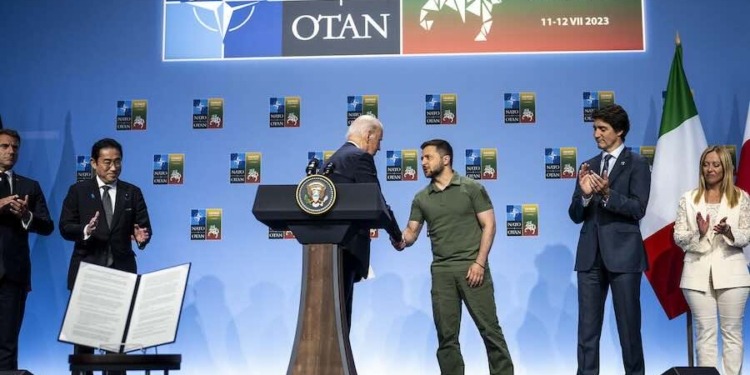International Monetary Fund (IMF) staff and the Ukrainian authorities have reached staff level agreement (SLA) on the Sixth Review of the 4-year Extended Fund Facility (EFF) Arrangement. Subject to approval by the IMF Executive Board, Ukraine would have access to about US$1.1 billion (SDR 834.9 million), bringing total disbursements under the program to US$9.8 billion.
Program performance remains strong. The authorities met all end-September quantitative performance criteria (QPCs) and the structural benchmarks for the review. Understandings were also reached on a set of policies and reforms to sustain macroeconomic stability as the war continues.
The outlook remains exceptionally uncertain and Russia’s war in Ukraine continues to take a heavy toll on Ukraine’s people, economy, and infrastructure. Despite the challenging environment, the program remains on track on the back of critical external support, including the G7’s ERA Initiative that is expected to provide US$50 billion in financing to Ukraine.
By March 2024, mostly Western governments had pledged more than $380 billion worth of aid to Ukraine since the invasion, including nearly $118 billion in direct military aid from individual countries. European countries have provided the most aid in total (military, financial and humanitarian), while the United States has by far provided the most military aid.
Most of the US funding supports American industries who produce weapons and military equipment.
U.S. Support
Ukraine is a key regional strategic partner of USA that has undertaken significant efforts to modernize its military and increase its interoperability with NATO. It remains an urgent security assistance priority to provide Ukraine the equipment it needs to defend itself against Russia’s war against Ukraine.
To date, U.S. has provided more than $64.1 billion in military assistance since Russia launched its premeditated, unprovoked, and brutal full-scale invasion of Ukraine on February 24, 2022, and approximately $66.9 billion in military assistance since Russia’s initial invasion of Ukraine in 2014. U.S. now used the emergency Presidential Drawdown Authority on 55 occasions since August 2021 to provide Ukraine military assistance totaling approximately $31.7 billion from DoD stockpiles.
Air Defense
Three Patriot air defense batteries and munitions;
12 National Advanced Surface-to-Air Missile Systems (NASAMS) and munitions;
HAWK air defense systems and munitions;
AIM-7, RIM-7, and AIM-9M missiles for air defense;
More than 3,000 Stinger anti-aircraft missiles;
Avenger air defense systems;
VAMPIRE counter-Unmanned Aerial Systems (c-UAS) and munitions;
c-UAS gun trucks and ammunition;
Mobile c-UAS laser-guided rocket systems;
Other c-UAS equipment;
Anti-aircraft guns and ammunition;
Air defense systems components;
Equipment to integrate Western launchers, missiles, and radars with Ukraine’s systems;
Equipment to support and sustain Ukraine’s existing air defense capabilities; and
21 air surveillance radars.
Fires
More than 40 High Mobility Artillery Rocket Systems (HIMARS) and ammunition;
Ground-Launched Small Diameter Bomb launchers and guided rockets;
More than 200 155mm Howitzers and more than 3,000,000 155mm artillery rounds;
More than 7,000 precision-guided 155mm artillery rounds;
More than 70,000 155mm rounds of Remote Anti-Armor Mine (RAAM) Systems;
72 105mm Howitzers and more than 800,000 105mm artillery rounds;
10,000 203mm artillery rounds;
More than 400,000 152mm artillery rounds;
Approximately 40,000 130mm artillery rounds;
40,000 122mm artillery rounds;
60,000 122mm GRAD rockets;
More than 200 mortar systems;
More than 600,000 mortar rounds;
More than 100 counter-artillery and counter-mortar radars; and
More than 50 multi-mission radars;
Ground Maneuver
31 Abrams tanks;
45 T-72B tanks;
More than 300 Bradley Infantry Fighting Vehicles;
Four Bradley Fire Support Team vehicles;
189 Stryker Armored Personnel Carriers;
More than 900 M113 Armored Personnel Carriers;
More than 400 M1117 Armored Security Vehicles;
More than 1,000 Mine Resistant Ambush Protected (MRAP) Vehicles;
More than 5,000 High Mobility Multipurpose Wheeled Vehicles (HMMWVs);
More than 200 light tactical vehicles;
300 armored medical treatment vehicles;
80 trucks and more than 200 trailers to transport heavy equipment;
More than 1,000 tactical vehicles to tow and haul equipment;
153 tactical vehicles to recover equipment;
10 command post vehicles;
30 ammunition support vehicles;
27 armored bridging systems;
20 logistics support vehicles and equipment;
239 fuel tankers and 105 fuel trailers;
58 water trailers;
Six armored utility trucks;
125mm, 120mm, and 105mm tank ammunition;
More than 1,800,000 rounds of 25mm ammunition; and
Mine clearing equipment.
Aircraft and Unmanned Aerial Systems
20 Mi-17 helicopters;
Switchblade Unmanned Aerial Systems (UAS);
Phoenix Ghost UAS;
CyberLux K8 UAS;
Altius-600 UAS;
Jump-20 UAS;
Hornet UAS
Puma UAS;
Scan Eagle UAS;
Penguin UAS;
Two radars for UAS;
High-speed Anti-radiation missiles (HARMs);
Air-to-ground munitions;
More than 6,000 Zuni aircraft rockets;
More than 20,000 Hydra-70 aircraft rockets; and
Munitions for UAS.
Anti-armor and Small Arms
More than 10,000 Javelin anti-armor systems;
More than 120,000 other anti-armor systems and munitions;
More than 10,000 Tube-Launched, Optically-Tracked, Wire-Guided (TOW) missiles;
More than 50,000 grenade launchers and small arms;
More than 400,000,000 rounds of small arms ammunition and grenades;
Laser-guided rocket systems and munitions;
Rocket launchers and ammunition; and
Anti-armor mines.
Maritime
Two Harpoon coastal defense systems and anti-ship missiles;
More than 100 coastal and riverine patrol boats;
Unmanned Coastal Defense Vessels; and
Port and harbor security equipment.
Other capabilities
M18A1 Claymore anti-personnel munitions;
C-4 explosives, demolition munitions, and demolition equipment for obstacle clearing;
Obstacle emplacement equipment;
Counter air defense capability;
More than 100,000 sets of body armor and helmets;
Tactical secure communications systems and support equipment;
Four satellite communications (SATCOM) antennas;
SATCOM terminals and services;
Electronic warfare (EW) and counter-EW equipment;
Commercial satellite imagery services;
Night vision devices, surveillance and thermal imagery systems, optics, and rangefinders;
Equipment to protect critical national infrastructure;
Explosive ordnance disposal equipment and protective gear;
Chemical, Biological, Radiological, Nuclear protective equipment;
Medical supplies, including first aid kits, bandages, monitors, and other equipment;
Field equipment, cold weather gear, generators, and spare parts; and
Support for training, maintenance, and sustainment activities.
To date, nearly 50 Allies and partner countries have provided security assistance to Ukraine. Among their many contributions to Ukraine, Allies and partners have delivered 10 long-range Multiple Launch Rocket Systems (MLRS), 178 long-range artillery systems, nearly 100,000 rounds of long-range artillery ammunition, nearly 250,000 anti-tank munitions, 359 tanks, 629 armored personnel carriers and infantry fighting vehicles (IFVs), 8,214 short-range air defense missiles, and 88 lethal UAVs.
To date, Congress has appropriated $4.65 billion in Foreign Military Financing (FMF) across two supplemental packages for Ukraine and “countries impacted by the situation in Ukraine.” Of this total, $4 billion has been notified to Congress. The first Ukraine supplemental also provided $4 billion in FMF loan authority and $4 billion in loan guarantees to NATO Allies.
In FY 2023, DoD provided $12.1 billion in security assistance to Ukraine under the Ukraine Security Assistance Initiative (USAI) in eight separate tranches.
In FY 2023, the Department notified Congress of our intent to make an additional $1.1 billion in long-term investments with FMF to bolster the security of Ukraine and 13 regional partners and allies in Europe who are at risk from potential future Russian aggression. These funds will help our allies and partners in the region to backfill military capabilities they have donated to Ukraine, enable new donations to Ukraine, and support longer-term military requirements in both the broader region and in Ukraine itself. On September 6, 2023, the Secretary announced an additional $100 million in Foreign Military Financing to support Ukraine’s longer-term military requirements.
On September 8, 2022, the Department notified Congress of our intent to make a further $2.2 billion available in long-term investments under Foreign Military Financing (FMF) to bolster the security of Ukraine and 17 of its regional neighbors; including both many of our NATO allies as well as other regional security partners who are most potentially at risk for future Russian aggression. These funds will help our allies and partners who have provided security assistance to Ukraine backfill their capabilities.
On April 24, 2022, the Department notified Congress of its intention to obligate more than $713 million in Foreign Military Financing funding for Ukraine and 15 other Allied and partner nations in Central and Eastern Europe and the Balkans. Assistance in this Notification will help NATO Allies backfill capabilities they have donated to Ukraine from their own stockpiles to retain and strengthen NATO deterrence.
In FY 2022, DoD provided $6.3 billion in security assistance to Ukraine under the Ukraine Security Assistance Initiative (USAI) in seven separate tranches. All the FY2022 USAI funds appropriated by Congress have now been committed. In FY 2021, Ukraine received $275 million under DoD’s Ukraine Security Assistance Initiative (USAI). This included $75 million in lethal assistance.

































Discussion about this post